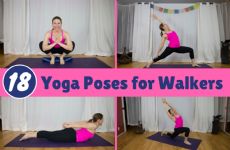|
Walking is a great form of exercise, whether you’re a beginner or a seasoned athlete. It’s cheap. It’s accessible. It doesn’t require any fancy equipment. And it’s something that nearly everyone can do. Walking is a big part of my own fitness program. In addition to higher-intensity workouts that include running and Spinning, I get out and walk about 4 times per week to shake things up and get a little active recovery. Bonus: In addition to elevating your heart rate and increasing circulation, walking at a brisk pace can burn up to 300 calories per hour! When you’re new to fitness, walking is a great way to start. But as you get fitter, can you still make walking work for you without turning into a runner? You bet! Here are some of my top recommendations to step-up the intensity of your walks. 1. Add (the right kind of) weight. While SparkPeople doesn’t recommend holding weights in your hands, wearing wrist weights or strapping on ankle weights in order to burn more calories or up your intensity, you can safely add weight to your walks by wearing a weighted vest. Unlike weights held at (or strapped to) your extremities, which can alter your normal movement patterns and gait, thereby increasing your risk of injury, a weighted vest centers the weight on your body so you can increase the intensity safely. Most weighted vests are adjustable, meaning you can start with less weight and slowly add more as you become accustomed to it. They’ll vary in price, but comfort and close-fit to your body are a must. We loved testing this 10-pound vest sent to us by Hyper Wear (retail $169.99), but you can find more economical options online and at sporting goods stores. Hint: Always try them on for comfort and fit; a good weighted vest should be snug, adjustable and keep the weight close to your body. 2. Add incline. If you walk outdoors, take to the hills. If you use a treadmill, it’s time to ramp up the incline. When walking on flat surfaces begins to feel easier, you can keep challenging yourself by playing up the incline. Even walking at the same pace, you’ll burn more calories. Walking uphill also helps strengthen your bones better than walking on flat surfaces does. I have a love-hate relationship with the hills of Cincinnati. They’re everywhere—and they’re steep. As much as they tire me out whether I’m running or walking, I also know that they’re helping me get fitter. With hill walking, be sure to do your share of downhill walking, too, to help balance out and strengthen your muscles. Just remember: What goes up must come down. No hills around? Take the stairs! 3. Add speed. This is one of the simplest things you can do boost the benefits of your walks, but be sure to do it carefully. To add speed, try to avoid taking longer or larger steps. Instead, take your normal-sized steps or slightly smaller steps and focus on a quicker turnover. Keep your elbows bent at 90 degrees and your shoulders relaxed as you pump your arms for additional momentum and balance, keeping your arms close to your body. Another great thing about walking faster (besides greater calorie burn) is that you’ll cover more distance in less time—a great technique for busy days. 4. Add intervals. Interval training, where you alternate higher and lower intensities throughout your workout, yields better fitness improvements and higher calorie burn than continuous or “steady-state” training alone. It can also help you improve your speed and amp up your walking intensity gradually. You can do intervals based on speed or incline (anything that gets you working harder)—even running! Then, you follow up with a lower-intensity recovery pace and repeat as many intervals as you’d like during your workout session. To learn more about interval training, read this article. Want to see some examples? Check out these interval workouts for walkers designed by Coach Jen. 5. Add volume. I’m all for music-free workouts that allow you to focus on your form, your body, or even the scenery. But many research studies have shown that listening to music gives exercisers a competitive edge that helps them go harder and longer before feeling fatigue. When you start increasing the intensity of your walks, consider adding a soundtrack to your workouts to you’re your body press a little harder or further. 6. Add poles. Nordic walking, which uses poles and can be done in any climate, is a great way to add more muscle power and intensity to your program. According to the Cooper Institute, Nordic walking burns 20% more calories than walking alone (sans poles). What’s more, Nordic walkers don’t perceive the intensity of their walks as harder, even though their heart rates are higher and they’re using more muscle fibers. Sounds like a win-win to me! 7. Subtract the treadmill. Treadmills are great when the weather is bad, you don’t live in a safe area, or you can’t get out of the house on certain days. But treadmills definitely make your walking workouts easier than they would be outdoors. If you’re ready to take your walks to the next level, hop off the treadmill and get walking on the ground—even if it’s indoors, like at a mall. You’ll use more muscle power (treadmills actually propel you forward), burn more calories—and really notice the difference! Learn more about how treadmills can cheat you out of a good workout here. 8. Subtract fancy "toning" shoes. They may claim to activate more muscles, burn more calories, and target your buns and thighs, but a recent independent study spearheaded by the American Council on Exercise found that these expensive products don't live up to their claims. Save your dollars and get better results than any get-fit-fast shoe can promise by incorporating the advice above. No matter what your fitness level, walking makes for great exercise that can grow with you! Be sure to check out SparkPeople’s comprehensive Walking Guide for more tips, workouts and get-fit strategies! Is walking part of your fitness routine? What’s your favorite way to add intensity to your walks? |
Popular Entries
Related Entries
More From SparkPeople
|




















.jpg)

